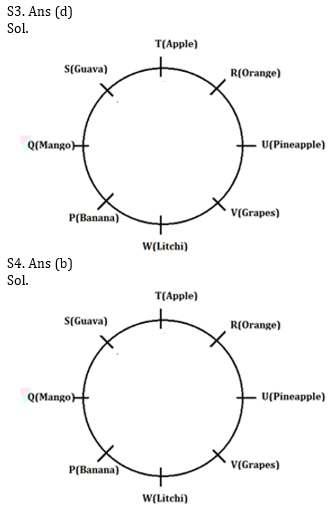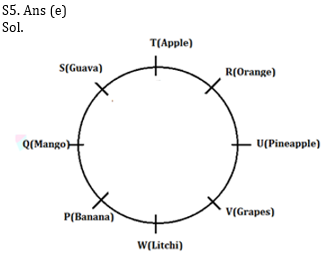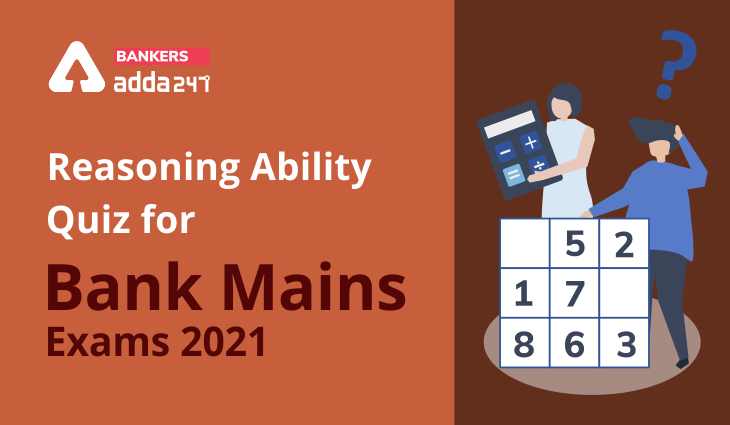Table of Contents
Directions (1-5): Study the following information carefully and answer the question given below:
Eight persons – P, Q, R, S, T, U, V and W sits around a circular table and they likes different fruits viz.- Mango, Litchi, Apple, Orange, Pineapple, Grapes, Guava and Banana, but not necessarily in the same order. P sits second to the right of S. U sits second to the right of the one, who likes litchi. The one who likes Pineapple sits second to the left of the one, who likes Apple. Two people sit between V and Q. Persons who like Orange and Grapes are adjacent to U. P likes Banana. Q does not like Guava and grapes. The one who likes Banana sits second to the right of the one who likes Guava. R and T is immediate neighbour of each other. Person who likes Apple sits fourth to the right of the one who likes Litchi. Only one person sits between R and the one who likes Guava. W sits third to the left of the one who likes orange. W like Litchi. Only three person sits between S and the one who likes Grapes.
Q1. What is the position of Q with respect to the one, who likes apple?
(a) Second to the left
(b) Second to the right
(c) Sixth to the left
(d) Third to the right
(e) Both (b) and (c)
Q2. Which of the following fruits does Q like?
(a) Pineapple
(b) Mango
(c) Apple
(d) Litchi
(e) None of these
Q3. Who sits opposite P?
(a) The one who likes litchi
(b) The one who likes apple
(c) The one who likes pine apple
(d) The one who likes orange
(e) None of these
Q4. Four of the following five are alike in a certain way and hence they form a group. Which one of the following does not belong to that group?
(a) S
(b) The one who likes Banana
(c) The one who likes apple
(d) The one who likes pine apple
(e) The one who likes Orange
Q5. U likes which of the following fruit?
(a) Orange
(b) Banana
(c) grapes
(d) apple
(e) pine apple
Directions (6-10): Each of the following questions below consists of a question and two statements numbered I and II given below it. You have to decide whether the data provided in the statements are sufficient to answer the question. Read both the statements and give answer.
Q6. Eight friends A, B, C, D, E, F, G and H are sitting around a circular table facing the center. Who is opposite to A?
I. D sits second to right of F and opposite to E. A is an immediate neighbor of B and C.
II. G sits third to right of E, who sits second to right of A.
(a) if the data in statement I alone are sufficient to answer the question, while the data in statement II alone are not sufficient in answer the question.
(b) if the data in statement II alone are sufficient to answer the question, while the data in statement I alone are not sufficient to answer the question.
(c) if the data in either in statement I alone or in statement II alone are sufficient to answer the question.
(d) if the data in both the statements I and II together are not sufficient to answer the question.
(e) if the data in both the statements I and II are together necessary to answer the question.
Q7. Who among D, E, F, G, H and J got the highest marks in an exam?
I. D’s marks was more than G and J and E’s marks was less than that of F.
II. E scored less than G. J scored more than G and H. No one scored marks between F and G or F and H.
(a) if the data in statement I alone are sufficient to answer the question, while the data in statement II alone are not sufficient in answer the question.
(b) if the data in statement II alone are sufficient to answer the question, while the data in statement I alone are not sufficient to answer the question.
(c) if the data in either in statement I alone or in statement II alone are sufficient to answer the question.
(d) if the data in both the statements I and II together are not sufficient to answer the question.
(e) if the data in both the statements I and II are together necessary to answer the question.
Q8. Among V, W, X, Y and Z, seated in a straight line facing south, who sits at the extreme end of the row?
I. W sits second to right of V. Z is not immediate neighbor of Y.
II. V sits third to left of Y. W sits on the immediate right of X.
(a) if the data in statement I alone are sufficient to answer the question, while the data in statement II alone are not sufficient in answer the question.
(b) if the data in statement II alone are sufficient to answer the question, while the data in statement I alone are not sufficient to answer the question.
(c) if the data in either in statement I alone or in statement II alone are sufficient to answer the question.
(d) if the data in both the statements I and II together are not sufficient to answer the question.
(e) if the data in both the statements I and II are together necessary to answer the question.
Q9. How is S related to E ?
I. W is father of X and P is grandson of E, who is wife of W.
II. G is mother of S and daughter in law of W.
(a) if the data in statement I alone are sufficient to answer the question, while the data in statement II alone are not sufficient in answer the question.
(b) if the data in statement II alone are sufficient to answer the question, while the data in statement I alone are not sufficient to answer the question.
(c) if the data in either in statement I alone or in statement II alone are sufficient to answer the question.
(d) if the data in both the statements I and II together are not sufficient to answer the question.
(e) if the data in both the statements I and II are together necessary to answer the question.
Q10. Among five friends P, Q, R, S and T having different heights, who is the tallest?
I. R is taller than only one friend. Only one friend is taller than T. P is not shortest.
II. R is shorter than three persons. Only one person is taller than T. P is neither the tallest nor the shortest in the group. Q is the shortest in group.
(a) if the data in statement I alone are sufficient to answer the question, while the data in statement II alone are not sufficient in answer the question.
(b) if the data in statement II alone are sufficient to answer the question, while the data in statement I alone are not sufficient to answer the question.
(c) if the data in either in statement I alone or in statement II alone are sufficient to answer the question.
(d) if the data in both the statements I and II together are not sufficient to answer the question.
(e) if the data in both the statements I and II are together necessary to answer the question.
Directions (11-15): Study the following information carefully and answer the following questions.
In alphabetical series A-Z each letter except vowels and Z is assigned a different number from 1-10 (for ex- B is coded as 1, C-2………..M-10)and again those numbers get repeated(for ex- N-1, P-2……..so on).
Also each vowel and Z is assigned a different symbol viz. #, $, %, @, &, *.
For ex-
“Remain am Brown” is coded as – 4*10@#1 @10 14$81
“You are good” is coded as – 10$% @4* 5$$3
“Zenith in topper” is coded as – &*1#66 #1 6$22*4
Q11. What can be the code of ‘Bankers?
(a) 1@18*52
(b) 1@81*45
(c) 1@18*54
(d)1@18*45
(e) None of these
Q12. What can be the code of ‘digital library’?
(a) 3#5#6$9 9#41@410
(b) 3#5#6@9 9#14@410
(c) 3#5#6@9 9#14@401
(d) 3#5#6@9 9#14@140
(e)None of these
Q13. What can be the code of ‘complexity’?
(a) 2$1029*96#10
(b) 2$1029*9#160
(c)2$1029*9#610
(d) 2$1029*9#601
(e)None of these
Q14. What can be the code of ‘Indian Culture’?
(a) #13#@1 2%96%4%
(b)#13#@1 2%96%4*
(c) #13#@1 2$96%4*
(d) #13#@1 2%95%4*
(e)None of these
Q15. What can be the code of ‘Nationality?
(a) 1@6#$1@9#611
(b) 1@6#$1@9#601
(c) 1@6#$1@9#160
(d) 1@6#$1@9#610
(e)None of these
Practice More Questions of Reasoning for Competitive Exams:
Solutions



S6. Ans.(a)
Sol. F is opposite to A.
S7. Ans.(e)
Sol. From statements I- D>G,J, F>E
From statement II- either J>H>F>G>E or J>G>F>H>E
From statement I and II both- D>J>H>F>G>E or D>J>G>F>H>E
Hence D got maximum marks.
S8. Ans.(e)
Sol. From both 1 and 2-
We can say that Y and Z are on the extreme end of the line.
S9. Ans.(d)
Sol. Because gender of S is not define so I and II together are not sufficient to answer.
S10. Ans.(b)
Sol. By statement II-
S>T>P>R>Q
S11. Ans.(d)
Sol. In this new pattern coding decoding each letter, except vowel and Z, is assigned a number from 1-10 So, B-1, C-2, D-3, F-4, G-5, H-6, J-7, K-8, L-9, M-10, N-1, P-2, Q-3, R-4, S-5, T-6, V-7, W-8, X-9, Y-10.
Each vowel is assigned a different symbol as-%, #, $, @, *, & So, For vowels the symbols are – A-@, E-*, I-#, O-$, U-% and Z-&.
1@18*45
S12. Ans.(b)
Sol. In this new pattern coding decoding each letter, except vowel and Z, is assigned a number from 1-10 So, B-1, C-2, D-3, F-4, G-5, H-6, J-7, K-8, L-9, M-10, N-1, P-2, Q-3, R-4, S-5, T-6, V-7, W-8, X-9, Y-10.
Each vowel is assigned a different symbol as-%, #, $, @, *, & So, For vowels the symbols are – A-@, E-*, I-#, O-$, U-% and Z-&.
3#5#6@9 9#14@410
S13. Ans.(c)
Sol. In this new pattern coding decoding each letter, except vowel and Z, is assigned a number from 1-10 So, B-1, C-2, D-3, F-4, G-5, H-6, J-7, K-8, L-9, M-10, N-1, P-2, Q-3, R-4, S-5, T-6, V-7, W-8, X-9, Y-10.
Each vowel is assigned a different symbol as-%, #, $, @, *, & So, For vowels the symbols are – A-@, E-*, I-#, O-$, U-% and Z-&.
2$1029*9#610
S14. Ans.(b)
Sol. In this new pattern coding decoding each letter, except vowel and Z, is assigned a number from 1-10 So, B-1, C-2, D-3, F-4, G-5, H-6, J-7, K-8, L-9, M-10, N-1, P-2, Q-3, R-4, S-5, T-6, V-7, W-8, X-9, Y-10.
Each vowel is assigned a different symbol as-%, #, $, @, *, & So, For vowels the symbols are – A-@, E-*, I-#, O-$, U-% and Z-&.
#13#@1 2%96%4*
S15. Ans.(d)
Sol. In this new pattern coding decoding each letter, except vowel and Z, is assigned a number from 1-10 So, B-1, C-2, D-3, F-4, G-5, H-6, J-7, K-8, L-9, M-10, N-1, P-2, Q-3, R-4, S-5, T-6, V-7, W-8, X-9, Y-10.
Each vowel is assigned a different symbol as-%, #, $, @, *, & So, For vowels the symbols are – A-@, E-*, I-#, O-$, U-% and Z-&.
1@6#$1@9#610
Practice with Online Test Series for Bank Mains 2021:
Click Here to Register for Bank Exams 2020 Preparation Material




 GA Capsule for SBI Clerk Mains 2025, Dow...
GA Capsule for SBI Clerk Mains 2025, Dow...
 The Hindu Review October 2022: Download ...
The Hindu Review October 2022: Download ...
 Importance of Descriptive Questions in S...
Importance of Descriptive Questions in S...





